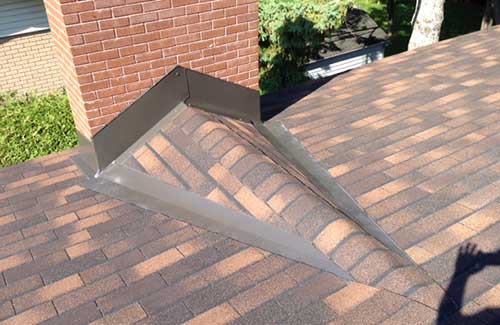You can’t construct a house without putting a roof on it. Otherwise, you could never live inside it. That is why it is necessary to know all the essential parts of the roofing system. If you overlook even a single part of it while inspecting, doing repairs, or replacing your shingles, then you could end up dealing with major damages and issues. Trust us, you are going to need more than just new shingles!
One of the integral pieces of the roofing system is called flashing. But what is roof flashing? And what is its purpose? We are going to answer all those questions and more.
What Is Roof Flashing?
Flashing is a thin, flat material that goes under the shingles or is left partially exposed to help with transporting rain and ice melt towards the gutters. Simply, flashing helps prevent moisture from getting beneath the shingles.
You will often find flashing in the following locations:
- Sidewalls: A vertical wall that meets the slope of a roof deck.
- Front walls/Headwalls: Vertical walls that are behind a sloped roof deck.
Of course, the edges and joints of the roof aren’t the only places where your roof benefits from flashing. There are other places where you can put down flashing and prevent future leaks. For example, chimneys often require flashing, because they pose a huge risk of moisture penetration around the base. However, you also need a special kind of flashing of chimneys—both in material and shape.
Seams between dormers and roofing also need to be tightly sealed. Another spot would be around skylights. Though skylights often come with their own flashing, you might need to add rubber gaskets beneath.
What Is The Purpose of Roof Flashing?
The primary purpose of flashing is protect a building during harsh water by keeping water from seeping beneath the shingles. Flashing works to reinforce weaker sections of the roofing system. If your roof system doesn’t have flashing, it won’t be able to withstand water damage for low and will be susceptible to damage during freezing in the winter and thawing in the spring.
What Types of Materials are Used For Flashing?
There is a long list of materials that roof flashing can be made from. Often, you will see flashing made out of copper, aluminum, zinc alloy, galvanized steel, stainless steel, and even rubber. Every material has unique properties, so you will need to discuss your options with a roofing professional to learn the pros and cons of each. Depending on your roof, one option might be better than the rest. Furthermore, these materials all have a different level of durability and cost.
Types of Flashing
Now, let’s look at the places where flashing can be applied in greater detail:
- Step flashing: Used where a roof deck contacts a sidewall. This flashing is angled to be in line with the pitch of the roof. Step flashing is installed at the point where the sidewall and roof deck comes together. Often, the flashing is visible along the sidewall, so you can choose more decorative styles to add aesthetic appeal.
- Base flashing (also known as continuous flashing): Used for headwalls (also called front walls). Installed to correlated with the pitch of the roof. You can find base flashing over the underlayment but under the siding and shingles. It is oftentimes not visible to the eye.
- Valley flashing: Seen where roof decks slant inward towards one another, creating a “valley” between “mountains.” Here, the shingles are installed so that they don’t touch, leaving the valley flashing visible so it can act like a gutter. Since you can see the flashing, most homeowners choose a color that contrasts with the shingles for aesthetic appeal.
- Drip Edges: Found along the edges of the roof, these direct water to gutters, preventing seepage.
- Chimney flashing: Flashing customized to fit around a chimney.
- Skylight flashing: Similar to chimney flashing, skylights have their own unique flashing. Every version of skylight needs a specific style of flashing.
- Vent flashing: Designed to fit a roof vent. Since most vents are unique, it is often harder to find one-size-fits-all vent flashing, and it may be harder to install that continuous and step flashing as well.
How Long Should Roof Flashing Last?
If your flashing is installed by a competent and professional roofing contractor—as it should be—then you can expect your flashing to last anywhere between 15 and 40 years. Naturally, with routine maintenance, some homeowners might see their flashing outlast their roof by 20 years or more. However, this greatly depends on the materials involved and the kind of climate you live in.
What Are Common Issues With Roof Flashing?
Now that you have learned about where you can find flashing and its purpose, you may be wondering what kind of problems can arise. Most roof flashing issues that homeowners deal with tend to be the result of poor installation or maintenance, but there are plenty of reasons why flashing can fail.
The common reasons roof flashing fails are:
- Improper installation: The most common cause behind flashing failure. This is because properly installing roof flashing can be difficult for DIYers, and so you oftentimes need to hire a professional. When flashing isn’t installed properly, it will fail to perform as desired and will also deteriorate at a much faster rate.
- Severe weather: Although flashing has been designed to withstand ice, rain, snow, hail, and wind, it is not impregnable. If you live in a region with a harsh climate or endure a particularly severe storm that rips shingles from the roof, your roof’s flashing might sustain damage as well. Sometimes, flashing can even more torn completely from the roof.
- Normal wear and tear: No matter how much you inspect and maintain, roof flashing is not meant to last an eternity. It will eventually need to be replaced.
- Human error: People who are unfamiliar with roofing will often attempt at installing shingles and flashing and other components of the roofing system and make mistakes. Flashing is resilient—but only when properly installed. Even if you accidentally step on flashing while moving around the roof, you can cause damage. Tread lightly!
Takeaway
Flashing is a pivotal piece of the roofing system. The more you know about roofing, the better prepared you are to inspect, maintain, repair, and replace your roof when the time comes. However, you should always let an expert do the work! Always contact a roofing professional if you are having problems with your flashing or suspect that something is wrong.




0 Comments